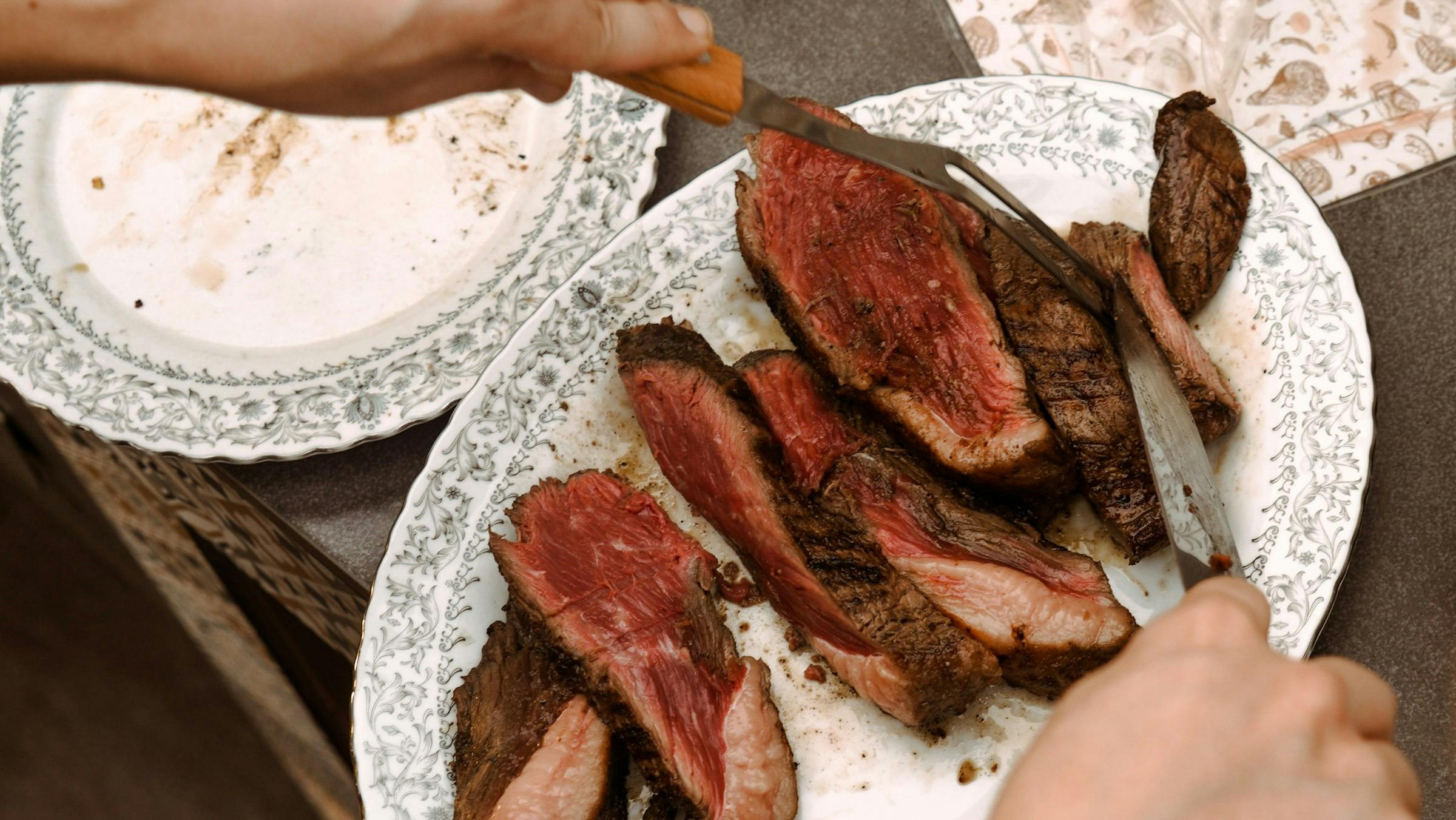Beef vs Chicken: Which Is Healthier for Weight Loss, Heart Health, and Longevity?
By Karyn O.
Reviewed by Kenya Bass, PA-C
Published Sep 1, 2025
15 min read

If you’ve ever stood in front of the meat section at the grocery store debating between beef and chicken, you’re not alone. Both are rich in protein, both can be part of a balanced diet, and both have loyal fans who swear their choice is the healthier option. For decades, chicken has been considered the “lighter” and more heart-friendly choice, while beef has carried the reputation of being richer, heavier, and sometimes riskier for long-term health. But is it really that simple?
The truth is, the beef versus chicken debate is far more nuanced than many headlines suggest. Each has unique nutritional benefits, and each can play a role in weight loss, heart health, and even longevity — depending on how it’s sourced, prepared, and eaten. Instead of asking, “Which is better?” a more useful question might be, “Which is better for me, right now, given my health goals?”
This article takes a deep dive into beef and chicken from multiple perspectives: nutrition, weight management, heart health, longevity, and even environmental and ethical considerations. By the end, you’ll have a clearer understanding of when beef may be the smarter choice, when chicken may serve you better, and how to enjoy both in ways that maximize their benefits while minimizing risks.
Nutritional Overview: Beef vs Chicken
When comparing beef and chicken, the first thing most people want to know is how they stack up nutritionally. Both are protein-rich, but there are meaningful differences in calories, fat, and micronutrients.
A typical three-ounce serving of skinless, boneless chicken breast provides about 140 calories, 26 grams of protein, and just 3 grams of fat. By contrast, a similar portion of lean ground beef (90% lean, 10% fat) contains around 180 calories, 24 grams of protein, and 10 grams of fat. Already, we can see chicken breast is leaner, which is why it often gets recommended in weight-loss diets.
But nutrition isn’t just about calories. Beef has an edge in certain micronutrients, particularly iron, zinc, and vitamin B12. These are nutrients critical for red blood cell production, immune function, and energy metabolism. For people prone to anemia, beef may be a better source of highly bioavailable heme iron compared to chicken. Chicken, on the other hand, is richer in niacin (vitamin B3), which supports healthy metabolism and nerve function, as well as selenium, an antioxidant mineral that helps protect cells from damage.
Protein quality also deserves attention. Both beef and chicken are considered “complete proteins,” meaning they contain all nine essential amino acids the body needs for muscle growth, repair, and overall function. This is why both meats are staples for athletes, bodybuilders, and anyone looking to maintain muscle as they age.
The type of fat matters too. Beef tends to have more saturated fat than chicken, which has traditionally raised concerns about cholesterol and heart health. However, beef — especially grass-fed beef — also contains higher levels of conjugated linoleic acid (CLA) and omega-3 fatty acids compared to conventional chicken, which may have health benefits of their own. Chicken, particularly dark meat with the skin on, contains more unsaturated fats, which are generally considered better for cardiovascular health.
So nutritionally, there’s no clear “winner.” Chicken breast is lower in fat and calories, making it a great choice for those trying to lose weight, while beef offers unique nutrients that chicken can’t match as easily.
Which Is Better for Weight Loss?
Weight loss ultimately comes down to creating a calorie deficit — burning more calories than you consume — but the type of foods you eat can make that process easier or harder. Protein is especially important in this equation because it helps you feel full longer, stabilizes blood sugar, and preserves lean muscle mass when you’re losing weight.
Chicken has long been considered a weight-loss staple. A plain grilled chicken breast provides high-quality protein with very few calories from fat. This makes it easy to build a filling meal that supports fat loss without going over your calorie budget. Many people on structured weight-loss programs turn to chicken repeatedly because it’s versatile, affordable, and consistent.
Beef, however, shouldn’t be dismissed in the weight-loss conversation. Lean cuts of beef, such as sirloin, tenderloin, or 90% lean ground beef, can also fit well into a calorie-conscious diet. While beef has more calories per ounce than chicken breast, it can be more satisfying due to its richer flavor and higher fat content. That satiety factor can actually prevent overeating later.
Interestingly, some research suggests people who include lean beef in their diet while following calorie-controlled plans lose just as much weight as those who rely primarily on poultry. In other words, beef isn’t automatically a barrier to weight loss — the key is choosing lean cuts, controlling portions, and avoiding cooking methods that add excess fat, such as deep frying.
So, for weight loss, chicken might seem like the obvious choice, but beef can be equally effective when eaten smartly. The real difference often comes down to personal preference, portion control, and cooking style.

Which Is Better for Heart Health?
Heart health is one area where beef often gets a bad reputation. Traditional dietary guidelines have warned against high consumption of red meat, citing its saturated fat and cholesterol content as potential contributors to cardiovascular disease. Indeed, diets heavy in processed red meats like bacon, sausage, and hot dogs have been strongly linked to higher risks of heart disease.
However, unprocessed lean beef may not deserve the same level of caution. Some recent studies suggest that moderate amounts of lean beef, as part of an overall balanced diet, may not significantly raise heart disease risk. In fact, when lean beef replaces refined carbs or processed foods in the diet, it may even support heart health.
Chicken is generally viewed as a more heart-friendly option, especially skinless chicken breast, which is naturally low in saturated fat. Diets such as the DASH diet and Mediterranean diet, both of which are associated with lower rates of heart disease, often include poultry as the primary animal protein.
But not all chicken is equal. Fried chicken, chicken nuggets, and other heavily processed poultry products can be loaded with unhealthy fats, sodium, and preservatives, which negate the heart health advantages of chicken. Similarly, fatty cuts of beef or beef cooked in butter and cream sauces can tip the balance toward harm rather than benefit.
Ultimately, heart health depends less on whether you choose beef or chicken and more on how much you eat, what cut you select, and how you prepare it. A grilled sirloin steak served with roasted vegetables is a far different meal from a double cheeseburger with fries, just as oven-baked chicken breast differs from fried chicken wings.
RELATED READ: Healthiest Steak Cuts: The Best Lean Meats for Nutrition, Weight Loss & Longevity
Which Is Better for Longevity and Chronic Disease Prevention?
When it comes to long-term health and longevity, scientists often look at patterns in large populations rather than individual nutrients. In this context, red meat (like beef) has been more strongly linked with chronic conditions such as colorectal cancer, type 2 diabetes, and heart disease compared to poultry. Some studies show higher mortality rates among people who eat large amounts of red meat, particularly processed forms.
Chicken, on the other hand, shows up more frequently in longevity-friendly eating patterns. The Mediterranean diet, for example, emphasizes fish and poultry while minimizing red meat, and has consistently been associated with longer life expectancy and reduced risk of chronic disease.
That said, moderate beef consumption doesn’t necessarily shorten life, especially if the meat is lean, minimally processed, and part of a diet rich in vegetables, whole grains, fruits, nuts, and legumes. In fact, certain nutrients found in beef, such as iron, zinc, and vitamin B12, are critical for long-term health and can be harder to obtain in adequate amounts without animal products.
What longevity research really teaches us is that balance and moderation matter more than strict avoidance. Eating beef every day in large portions may increase risks, but enjoying a few servings per week alongside plenty of plant foods is unlikely to be harmful for most people. Chicken may be the safer day-to-day staple for longevity, but beef can still play a valuable role when chosen carefully.
Key takeaways from the table:
- Chicken breast is lower in calories and fat, especially saturated fat, while providing slightly more protein.
- Beef delivers more iron, zinc, and vitamin B12, which are critical for blood health and energy.
- Both provide selenium and omega-3s, though amounts vary with how the animals are raised (grass-fed beef and pasture-raised chicken are more nutrient-dense).
- Chicken shines for weight management and heart health, while beef provides unique micronutrient advantages for people needing iron or B12.
Quality Matters: Grass-Fed, Organic, and Cooking Methods
Not all beef and chicken are created equal. The way animals are raised and the way meat is cooked can make a big difference in health outcomes.
Grass-fed beef typically has a healthier fat profile than grain-fed beef, with more omega-3 fatty acids and antioxidants. It also contains higher levels of conjugated linoleic acid (CLA), which may have potential benefits for fat metabolism and immune function. Similarly, pasture-raised chicken tends to have more omega-3s and may be lower in inflammatory omega-6 fatty acids compared to conventionally raised chicken.
Cooking methods matter too. Grilling, baking, or roasting are generally healthier than deep frying, which adds extra calories and unhealthy fats. At the same time, cooking meats at very high temperatures, especially over open flames, can create compounds like heterocyclic amines (HCAs) and advanced glycation end products (AGEs), which may increase the risk of cancer and inflammation. To minimize these risks, it’s best to avoid charring meat, use marinades with herbs and spices, and pair meats with antioxidant-rich vegetables.
Choosing minimally processed forms of beef and chicken is also crucial. Highly processed meats — think deli slices, sausages, nuggets, and fast-food options — are consistently linked with worse health outcomes. If health is your priority, fresh cuts of beef and chicken are always the smarter choice.
Environmental and Ethical Considerations
Beyond personal health, many people today also weigh the environmental and ethical aspects of their food choices. Beef production has a significantly larger carbon footprint compared to chicken. Cows require more land, water, and feed, and they produce more methane, a potent greenhouse gas. From a sustainability standpoint, replacing beef with chicken or plant-based proteins is often seen as a more environmentally friendly option.
Ethical considerations also come into play. Choosing organic, grass-fed, or pasture-raised meats can support better animal welfare practices, though they are usually more expensive. For some consumers, aligning food choices with personal values about sustainability and animal welfare is just as important as nutrition.
RELATED READ: Is Chicken Healthy for You? Benefits, Risks & the Healthiest Ways to Eat It
Practical Tips for Choosing Between Beef and Chicken

So, when should you reach for beef, and when should you choose chicken? If your goal is weight loss or heart health, skinless chicken breast is often the leanest and most practical choice. If you struggle with iron deficiency or want a nutrient-dense source of B12 and zinc, lean beef may be more beneficial.
Portion control is essential no matter which you choose. A healthy serving size of meat is typically about three to four ounces — roughly the size of a deck of cards. Eating balanced meals by pairing beef or chicken with fiber-rich vegetables, whole grains, and healthy fats ensures you’re getting more than just protein on your plate.
Cooking style can make or break the healthfulness of a dish. Grilling, baking, roasting, or stir-frying with a small amount of healthy oil are generally the best options. Limiting fried, processed, or heavily sauced preparations will keep your meals more nutrient-dense and lower in unhealthy fats, sodium, and calories.
The Bottom Line: Beef vs Chicken
The debate over beef versus chicken doesn’t have a simple winner because both meats can be part of a healthy diet when eaten thoughtfully. Chicken tends to shine as the leaner, more heart-friendly choice, making it a staple in many weight-loss and longevity-focused diets. Beef, while sometimes criticized for its saturated fat and links to chronic disease, remains an excellent source of iron, zinc, B12, and other nutrients that support energy, muscle, and overall health.
Rather than choosing one over the other, the smartest approach is variety and moderation. Eating mostly chicken with occasional servings of lean, high-quality beef can give you the best of both worlds — the lightness and heart-health benefits of poultry combined with the nutrient density of red meat.
In the end, your health depends less on whether you eat beef or chicken and more on the overall quality of your diet. A plate that balances protein with colorful vegetables, fiber-rich grains, and healthy fats will always serve you better than focusing on one food in isolation. So, instead of asking which meat is healthier in absolute terms, consider what your body needs, what your goals are, and how your choices fit into your bigger picture of lifelong health and well-being.
Frequently Asked Questions: Beef vs Chicken
1. Is beef or chicken better for building muscle?
Both beef and chicken are excellent for muscle building because they are complete proteins with all nine essential amino acids. Chicken breast is leaner, so it gives you more protein per calorie, which can help if you’re trying to stay lean while gaining muscle. Beef, however, has the added benefit of iron, zinc, and creatine — all of which support energy, muscle recovery, and strength. For athletes and weightlifters, including both chicken and lean cuts of beef may be the best strategy.
2. Which is easier to digest: beef or chicken?
Chicken is usually easier to digest than beef because it is leaner and has less connective tissue. People with sensitive stomachs, digestive disorders, or recovering from illness often tolerate chicken breast better. Beef, especially fattier or tougher cuts, can take longer to digest. However, ground beef or slow-cooked beef tends to be gentler on the digestive system.
3. Can I eat beef and chicken in the same day?
Yes, you can eat both in the same day. In fact, rotating protein sources is beneficial because it provides a wider range of nutrients. For example, you might have chicken breast for lunch and lean beef for dinner. What matters more is portion size, balance with vegetables and whole grains, and overall calorie intake.
4. Is chicken always healthier than beef?
Not necessarily. While chicken is lower in fat and calories, beef provides more iron, zinc, and vitamin B12. For someone with anemia, beef may actually be the healthier choice. The “healthier” option depends on your goals — weight management, heart health, or correcting nutrient deficiencies.
5. Which is better for people with high cholesterol: beef or chicken?
Skinless chicken breast is generally better for people with high cholesterol because it is very low in saturated fat. Beef, especially fatty cuts, contains more saturated fat, which may raise LDL cholesterol in some individuals. That said, lean cuts of beef in moderation can still fit into a cholesterol-friendly diet if paired with plenty of fiber-rich vegetables and whole grains.
6. Is grass-fed beef healthier than regular beef?
Yes, grass-fed beef usually has a healthier fat profile. It tends to contain more omega-3 fatty acids, antioxidants, and conjugated linoleic acid (CLA). It’s also often raised with fewer hormones and antibiotics, depending on farming practices. While it’s more expensive, grass-fed beef can be a better option for people prioritizing nutrition quality.
7. Can eating too much chicken be unhealthy?
Yes. While chicken is lean and nutrient-rich, eating it excessively — especially if it’s fried or heavily processed (like nuggets or deli meat) — can contribute to excess sodium, unhealthy fats, and an imbalanced diet. Relying only on chicken may also mean missing out on important nutrients found in other protein sources like beef, fish, eggs, and legumes.
8. Which is better for weight loss: chicken thighs or lean beef?
Skinless chicken thighs have slightly more fat than chicken breast but are still leaner than many cuts of beef. Lean beef (like sirloin or tenderloin) can still work for weight loss, but chicken thighs are usually lower in calories per serving. The key is how they’re cooked — grilled or baked options are much better than fried.
9. Does red meat like beef really increase cancer risk?
Research shows that eating large amounts of red meat, especially processed red meat like bacon, sausage, or hot dogs, is linked to a higher risk of colorectal cancer. Lean, unprocessed beef eaten in moderation (a few times per week) is not considered as risky. Pairing beef with vegetables high in antioxidants and fiber may also help reduce potential risks.
10. Which is more environmentally friendly: beef or chicken?
Chicken has a much smaller environmental footprint than beef. Producing beef requires more land, water, and feed, and cows release more methane gas, which contributes to climate change. For people concerned about sustainability, choosing chicken (or even plant-based proteins) more often than beef is generally a greener choice.
Share this article

Low Sodium Diet: Simple Guidelines, Food Lists, and Tips for Better Health
Lilian E.
Sep 30, 202512 min read

Does Coconut Milk Affect Blood Sugar Levels? A Complete Guide for Diabetes and Healthy Living
Karyn O.
Sep 29, 202510 min read

5 Best Bone Broths for Health, Nutrition, and Gut Support (Nutritionist-Backed Guide)
Karyn O.
Sep 24, 202511 min read

Best-in-class care is a click away
Find everything and everyone you need to reach your metabolic health goals, in one place. It all makes sense with Meto.
Join Meto